Wikipedia:Picture of the day/September 2009
|
Featured picture tools: |
These featured pictures, as scheduled below, appeared as the picture of the day (POTD) on the English Wikipedia's Main Page in September 2009. Individual sections for each day on this page can be linked to with the day number as the anchor name (e.g. [[Wikipedia:Picture of the day/September 2009#1]] for September 1).
You can add an automatically updating POTD template to your user page using {{Pic of the day}} (version with blurb) or {{POTD}} (version without blurb). For instructions on how to make custom POTD layouts, see Wikipedia:Picture of the day.Purge server cache
September 1

|
The Fiddler beetle (Eupoecila australasiae) is a colourful green- or yellow-and-black member of the scarab beetle family from eastern Australia measuring from 1.5 to 2 cm (0.59 to 0.79 in) in length. These beetles are strong flyers and can fly without moving the elytra. They spend much of the time searching for nectar and plant exudates. Photo credit: Fir0002
Recently featured:
|
September 2

|
The Japanese Instrument of Surrender, signed on board the USS Missouri in Tokyo Bay on September 2, 1945, was the written agreement that enabled the Surrender of Japan, ending World War II. It was signed by representatives from Japan, the United States, China, the United Kingdom, the Soviet Union, Australia, Canada, France, the Netherlands, and New Zealand.
Recently featured:
|
September 3

|
The remains of a trailer park in Sylmar, California, a neighborhood of Los Angeles. The damage was due to the November 2008 Sayre Fire, which destroyed 480 of the park's 600 units, plus an additional nine homes, the worst loss of homes due to fire in the city's history. However, there were no fatalities and only minor injuries to six people. Photo credit: Michael Mancino, FEMA
Recently featured:
|
September 4

|
|
A panoramic view of the historic penitentiary at Port Arthur, Tasmania, Australia, a former penal colony located 60 kilometres (37 mi) southeast of Hobart. Named after Van Diemen's Land lieutenant governor George Arthur, the settlement started as a timber station in 1830, but it became the country's largest penal station in 1833. It is now an open air museum and Tasmania's top tourist attraction. Photo credit: Noodle snacks
Recently featured:
|
September 5

|
An illustration depicting eighteenth century social dance, with the caption reading, "A cheerful dance awakens love and feeds hope with lively joy." The focuses of social dance are sociability and socializing, which differs from other forms, such as ceremonial, competitive, or performance. Social dances are usually partner or group dances. Illustration credit: Giuseppe Piattoli
Recently featured:
|
September 6
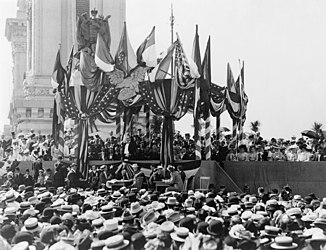
|
William McKinley, the 25th President of the United States, giving his last public address at the Pan-American Exposition in Buffalo, New York, standing under the gazebo, hatless, wearing a tuxedo and holding speech notes in his hand, one day before he was shot on September 6, 1901. One bullet was extracted, but the second was not, and McKinley eventually died of gangrene from his wound, eight days later. Photo credit: Charles Dudley Arnold
Recently featured:
|
September 7

|
A 1908 photo of child laborers in a glass factory in Indiana, United States, taken by Lewis Hine for the National Child Labor Committee, which formed after the 1900 census revealed that about 1 in 6 children between the ages of five and ten were gainfully employed. Hine's photos of children working in industrial settings resulted in a wave of popular support for federal child labor regulations put forward by the NCLC. Photo credit: Lewis Wickes Hine; restored by Michel Vuijlsteke
Recently featured:
|
September 8
|
A film showing laborers digging through rubble for bodies killed as a result of the 1900 Galveston hurricane, which struck the city of Galveston, Texas, United States, on September 8, 1900. At the time this film was shot the stench of decomposing corpses could be smelled for miles. One body was discovered in this pile (but not filmed) while the camera crew was present. Film credit: Edison Manufacturing Co.
Recently featured:
|
September 9

|
Hypericum calycinum is a low-growing shrub indigenous to southeast Europe and southwest Asia, but widely cultivated for its large yellow flowers. It is a popular, semi-evergreen garden shrub with many named cultivars and hybrids derived from it. Photo credit: Noodle snacks
Recently featured:
|
September 10

|
Two robber flies, the common name for insects in the family Asilidae, mating on an apple tree leaf. Robber flies prey upon other insects and spiders. Photo credit: Fir0002
Recently featured:
|
September 11
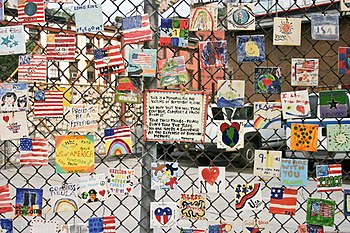
|
A collection of hand-painted tiles adorns this fence in Greenwich Village in Manhattan as a memorial for the attacks of September 11, 2001. Recurring themes within these pieces of art include world peace, American patriotism, and appreciation of the heroism of the FDNY and NYPD. Photo credit: David Iliff
Recently featured:
|
September 12

|
Jacqueline Kennedy, throwing the bouquet of flowers after her wedding to then-U.S. Senator John F. Kennedy on September 12, 1953. The wedding, held in Newport, Rhode Island, had an attendance of approximately 700 and was followed by the wedding reception at Jacqueline's childhood home, known as Hammersmith Farm. Her wedding dress and the dresses of her attendants were created by designer Ann Lowe, and the former is now housed in the Kennedy Library in Boston, Massachusetts. Photo credit: Toni Frissell |
September 13

|
A ca. 1900 photochrom of the Singel, a canal in Amsterdam, the Netherlands, with the Munttoren tower in the background. The canal served as a moat around the city until 1585, when Amsterdam expanded beyond the Singel. It is now the innermost canal in Amsterdam's semicircular ring of canals. Image credit: Detroit Publishing Co. |
September 14

|
|
A false-color far-infrared composite image of the Andromeda Galaxy, the nearest spiral galaxy to the Milky Way. The image consists of 11,000 separate exposures taken by the Spitzer Space Telescope's Multiband Imaging Photometer at 24 micrometres. The image is dominated by emission from hot cosmic dust; this is the sharpest image ever taken of this component of the interstellar medium in another galaxy. This is in dramatic contrast to the more-familiar view at visible wavelengths, which is dominated by starlight. Image credit: NASA/JPL-Caltech/K. Gordon (University of Arizona) |
September 15

|
A Mallet steam locomotive of the Eritrean Railway, the only railway system in Eritrea. Originally constructed by the Kingdom of Italy when Eritrea was its colony, the railway, which connects Massawa to Asmara, was heavily damaged in World War II as well as the Eritrean War of Independence. It was only rebuilt in the 1990s and continues to use equipment from the 1930s. Photo credit: Tivedshambo
Recently featured:
|
September 16

|
|
A view of the greater Hobart area, as seen from Mount Wellington. The state capital and most populous city of the Australian island state of Tasmania, Hobart is located in the state's south-east, on the estuary of the River Derwent. Photo credit: Noodle snacks
Recently featured:
|
September 17

|
A 2003 Australian Mazda6 sedan, a mid-size car produced by the Japanese car manufacturer Mazda. It is the successor to the Mazda 626, and has sold over one million units worldwide since its introduction in 2002, hitting that sales milestone faster than any previous Mazda. Photo credit: John O'Neill
Recently featured:
|
September 18

|
The eye of Hurricane Isabel as seen from the International Space Station, five days before it made landfall on the Outer Banks of North Carolina on September 18, 2003. At the time of the image, Isabel was located about 450 miles (720 km) northeast of Puerto Rico, and had weakened to a Category 4 hurricane, from its peak as a Category 5. Photo credit: Ed Lu
Recently featured:
|
September 19
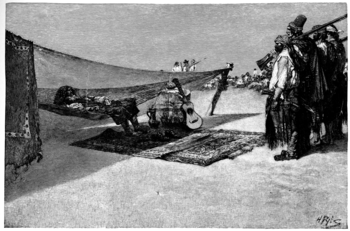
|
A pirate captain relaxes in a hammock, in this illustration from Howard Pyle's Book of Pirates (1921), which compiled a number of legends of piracy in the Caribbean. The classic era of piracy in the Caribbean extends from around 1560 up until the mid 1720s. Image credit: Howard Pyle
Recently featured:
|
September 20

|
An Old World screw-worm fly (Chrysomya albiceps), a species of blow-fly, feeding on decomposing matter. Like other members of the Chrysomya genus, these insects are an important tool in forensic science and forensic entomology due to their ability to smell dead animal matter over a long distance. Photo credit: Muhammad Mahdi Karim
Recently featured:
|
September 21
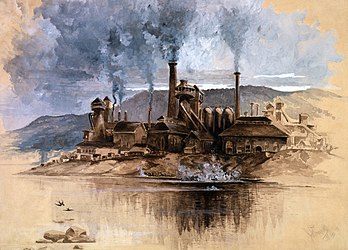
|
An 1881 watercolor painting of the Bethlehem Iron Works in Bethlehem, Pennsylvania. The company, once the second-largest steel producer in the United States, provided the steel for such landmarks as the Golden Gate Bridge, Madison Square Garden, and Hoover Dam. Artist: Joseph Pennell
Recently featured:
|
September 22

|
A columbine cultivar 'Magpie' flower. Columbines, the common name for plants in the Aquilegia genus, are herbaceous perennial plants found in meadows, woodlands, and at higher altitudes throughout the Northern Hemisphere. They are known for their distinctive flowers, generally bell-shaped, with each petal modified into an elongated nectar spur. Photo credit: Noodle snacks
Recently featured:
|
September 23

|
Wavefronts from a point source in the context of Snell's law, which describes the relationship between the angles of incidence and refraction, when referring to light or other waves, passing through a boundary between two different isotropic media, such as water and glass. The region below the gray line has a higher index of refraction and proportionally lower wave velocity than the region above it. The dotted red line is perpendicular to the wavefronts and thus represents a Fermat-shortest path from the source to a point in the lower medium. Image credit: Oleg Alexandrov
Recently featured:
|
September 24
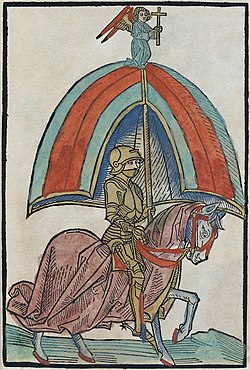
|
A knight, a member of the warrior class of the Middle Ages in Europe, in Gothic plate armour, from a German book illustration published 1483. The modern concept of the knight is as an elite warrior sworn to uphold the values of chivalry, faith, loyalty, courage and honour. Knighthood as known in Medieval Europe was characterized by the combination of two elements: feudalism and service as a mounted combatant. Both arose under the reign of the Holy Roman Emperor Charlemagne, from which the knighthood of the Middle Ages can be seen to have had its genesis. Illustration: Anton Sorg; Restoration: Lise Broer
Recently featured:
|
September 25

|
|
A roughly 180-degree panoramic image of Hoddle Grid, the original central business district of Melbourne, Australia, with Southbank on the opposite side (on the right) of the Yarra River, as viewed from the observation deck of the Rialto Towers, facing from north (left) to east (centre) to south (right). The locale is named after its designer, Robert Hoddle, and was laid out in 1837. Photo credit: David Iliff
Recently featured:
|
September 26

|
An 1892 aerial view of the village of Caledonia, New York, located in western New York. Named after Caledonia, the Roman name for Scotland, the village is located within the Town of Caledonia and was incorporated in 1891. Image: Burleigh Litho. Co.; Restoration: Lise Broer
Recently featured:
|
September 27
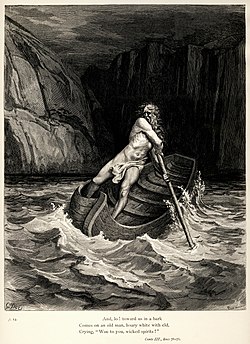
|
An engraving of Charon, in Greek mythology the ferryman of Hades who carried souls of the newly deceased across the River Styx that divided the world of the living from the world of the dead. This illustration is from French engraver Gustave Doré's 1857 set of illustrations for Dante Alighieri's Divine Comedy, an Italian epic poem depicting an allegorical vision of the Christian afterlife. Here, Charon is shown coming to ferry souls across the river Acheron to Hell. The caption is from Henry Francis Cary's translation, from which this particular copy is taken: And, lo! toward us in a bark Restoration: Adam Cuerden |
September 28

|
A late-16th-century illustration of cannon used in a siege, with a row of gabions, cylinders filled with soil or sand, in front of them for protection. In the medieval era, they were made from wicker with open tops and bottoms, so that they would be light and could be carried relatively conveniently in the ammunition train, particularly if they were made in several diameters to fit one in another. Illustration: Agostino Ramelli; Restoration: Lise Broer |
September 29

|
The Common bluetail (Ischnura heterosticta) is a small Australian damselfly of the family Coenagrionidae. Most males have blue eyes, blue thorax and a blue ringed tail. The females are green or light brown. Photo credit: Fir0002
Recently featured:
|
September 30
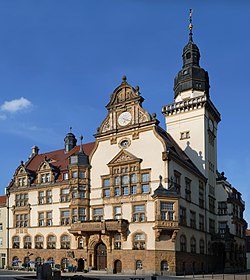
|
The town hall in Werdau, Zwickau district, Germany. In 1905, the city held a contest for the design of a new town hall, as the old one (built in 1727) had become too small. The tower and floor plan of one design was combined with the façade of another, and ground was broken for construction in 1908. Photo credit: André Karwath
Recently featured:
|
Picture of the day archives and future dates
